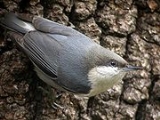
Pygmy Nuthatch
Encyclopedia

Songbird
A songbird is a bird belonging to the suborder Passeri of the perching birds . Another name that is sometimes seen as scientific or vernacular name is Oscines, from Latin oscen, "a songbird"...
, about 10 cm (4 inches) long and about 10 grams in weight. It ranges from southern British Columbia
British Columbia
British Columbia is the westernmost of Canada's provinces and is known for its natural beauty, as reflected in its Latin motto, Splendor sine occasu . Its name was chosen by Queen Victoria in 1858...
south through various discontinuous parts of the western
Western United States
.The Western United States, commonly referred to as the American West or simply "the West," traditionally refers to the region comprising the westernmost states of the United States. Because the U.S. expanded westward after its founding, the meaning of the West has evolved over time...
U.S.
United States
The United States of America is a federal constitutional republic comprising fifty states and a federal district...
(northwest U.S.
Northwestern United States
The Northwestern United States comprise the northwestern states up to the western Great Plains regions of the United States, and consistently include the states of Oregon, Washington, Idaho, Montana, Wyoming, to which part of southeast Alaska is also sometimes included...
, Sierra Nevada range, southern Rockies, etc.), to central Mexico
Mexico
The United Mexican States , commonly known as Mexico , is a federal constitutional republic in North America. It is bordered on the north by the United States; on the south and west by the Pacific Ocean; on the southeast by Guatemala, Belize, and the Caribbean Sea; and on the east by the Gulf of...
. It is usually found in pine
Pine
Pines are trees in the genus Pinus ,in the family Pinaceae. They make up the monotypic subfamily Pinoideae. There are about 115 species of pine, although different authorities accept between 105 and 125 species.-Etymology:...
s (especially Ponderosa Pine
Ponderosa Pine
Pinus ponderosa, commonly known as the Ponderosa Pine, Bull Pine, Blackjack Pine, or Western Yellow Pine, is a widespread and variable pine native to western North America. It was first described by David Douglas in 1826, from eastern Washington near present-day Spokane...
s), Douglas-fir
Douglas-fir
Douglas-fir is one of the English common names for evergreen coniferous trees of the genus Pseudotsuga in the family Pinaceae. Other common names include Douglas tree, and Oregon pine. There are five species, two in western North America, one in Mexico, and two in eastern Asia...
s, and other conifers. Pygmy Nuthatches clamber acrobatically in the foliage of these trees, feeding on insects and seeds; less often they creep along limbs or the trunk like bigger nuthatches.
Pygmy Nuthatches nest in cavities in dead stubs of conifers, lining the bottom of the cavity with pine-cone scales, plant down, and other soft plant and animal materials. They may fill cracks or crevices around the entrance with fur; the function of this behavior is unknown. The female lays 4–9 eggs, which are white with fine reddish-brown spotting. She does most of the incubation, which lasts about 16 days. The young leave the nest about 22 days after hatching.
This species is highly gregarious. A nesting pair may have other birds as helpers. Outside the breeding season, this bird wanders in noisy flocks. It also roosts communally; over 100 birds have been seen huddled in a single tree cavity.
All plumages are similar, with a warm gray cap, blue-gray upper-parts, and whitish underparts. The only feature not seen in the photograph is a whitish spot on the nape, particularly in worn plumage (summer). Vocalizations are highly varied chirps, peeps, and chattering.
This species is very similar to the Brown-headed Nuthatch
Brown-headed Nuthatch
The Brown-headed Nuthatch, Sitta pusilla, is a small songbird found in pine forests throughout the Southeastern United States. An endangered population occurs in the pineyards of Grand Bahama; some authorities consider it to represent a separate species, S. insularis...
of the southeastern U.S.
Southeastern United States
The Southeastern United States, colloquially referred to as the Southeast, is the eastern portion of the Southern United States. It is one of the most populous regions in the United States of America....
Their ranges have no overlap.
The Pygmy Nuthatch features prominently in the climax of the 2000 film Charlie's Angels
Charlie's Angels (film)
Charlie's Angels is a 2000 American action comedy film directed by McG, starring Cameron Diaz, Drew Barrymore, and Lucy Liu as three women working for a private investigation agency...
, in which Cameron Diaz
Cameron Diaz
Cameron Michelle Diaz is an American actress and former model. She became famous during the 1990s with roles in the movies The Mask, My Best Friend's Wedding, and There's Something About Mary. Other high-profile credits include the two Charlie's Angels films, voicing the character Princess Fiona...
's character, Natalie, discovers the location of the villains' fortress by identifying the call of the Pygmy Nuthatch, which she says only live in Carmel, California—though the bird shown is not a Pygmy Nuthatch, which in any case is found in a much wider range.
External links
- Pygmy Nuthatch - Sitta pygmaea - USGS Patuxent Bird Identification InfoCenter
- Pygmy Nuthatch Species Account - Cornell Lab of Ornithology
- Pygmy Nuthatch Information and Photos - South Dakota Birds and Birding
- Photographs of Pygmy Nuthatches nesting in a box
- Pygmy Nuthatch videos on the Internet Bird Collection
- Article & RangeMaps InfoNatura, NatureServe
- Pygmy Nuthatch photo gallery VIREO

